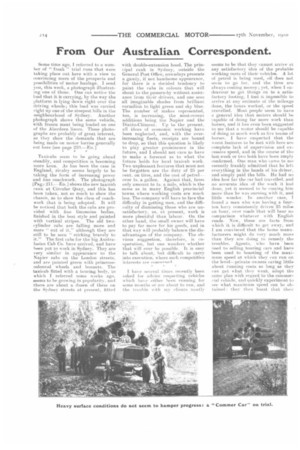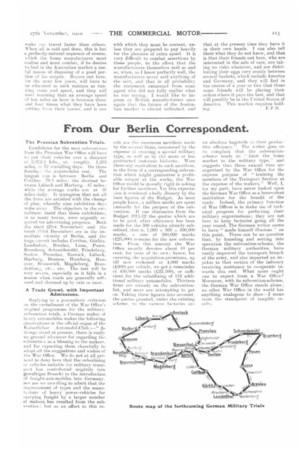From Our Australian Correspondent.
Page 6

Page 7

If you've noticed an error in this article please click here to report it so we can fix it.
Some time ago, I referred to a numher of " freak " trial runs that were taking place out here with a view to (mmvincing users of the prospects and possibilities of motor haulage. I send you, this week, a photograph illustrating one of these. One can notice the load that it is carrying, by the way the platform is lying down right over the driving wheels; this load was carried right up one of the steepest hills in the neighbourhood of Sydney. Another photograph shows the same vehicle, with frozen meat being loaded on one of the Aberdeen liners. These photographs are probably of great interest, as they show the demands that are being made on motor lorries generally out here [see page 210.—En.] Taxicabs seem to he going ahead steadily, and competition is becoming more keen. As has been the case in England, rivalry seems largely to be taking the form of increasing power and fine coachwork. The photograph [Page 21I.--Ev.1 shows the new taxicab rank at Circular Quay, and this has been taken, not so much to show the chassis, as to show the class of coachwork that is being adopted. It will be noticed that both the cabs are provided with fine limousine bodies, finished in the best style and painted with vertical stripes. The old twocylinder cabs are falling more and more " out of it," although they are still to be seen " sticking bravely to it." The first cabs for the big Australasian Cab Co. have arrived, and have been put to work in Sydney. They are very similar in appearance to the Napier cabs on the London streets, and are painted green with primrosecoloured wheels and bonnets. The taxicab fitted with a touring body, to which I referred some weeks ago. seems to be growing in popularity, and there are about a dozen of these on the Sydney streets at present, fitted with double-extension hood. The principal rank in Sydney, outside the General Post Office, nowadays presents a gaudy, if not handsome appearance, for there is a decided tendency to paint the cabs in colours that will shout to the passers-by without assistance from their drivers, and one sees all imaginable shades from brilliant vermilion to light green and sky blue. The number of makes represented, too, is increasing, the most-recent additions being the Napier and the Diatto-Clement. Up to the present. all ideas of economic working have been neglected, and, with the everincreasing fleets, receipts are hound to drop, ISO that this question is likely to play greater prominence in the future, and I should not care to have to make a forecast as to what the future holds for local taxicab work. Two unpleasant features that must not be forgotten are the duty of 25 per tent, on tires, and the cost of petrol-over Is. a gallon. Against that, fares only amount to Is. a mile, which is the same as in many English provincial towns where working costs are much less. The company will have to fare the difficulty in getting men, and the difficulty of dismissing those who are unsatisfactory, as, at present, work is more plentiful than labour. On the other hand, the small owner will have to pay far more for his goods, and in that way will probably balance the disadvantages of the company. The obvious suggestion, therefore, is cooperation, but one wonders whether that will ever be possible. It is easy to talk about, but difficult to carry into execution, where such competitive interests are l'OrlePrnPri , 1 have several times recently been asked for advice respecting vehicles which have either hen running for Si me months or are about to run, and
the trot title my clients !nosily
seems to be that they cannot arrive at any satisfactory idea of the probable working costs of their vehicles. A lot of petrol is being used, oil does not seem to go far, and the tires are always costing money; yet, when I endeavour to get things on to a satisfactory footing, I find it impossible to arrive at any estimate of the mileage done, the hours worked, or the speed travelled. Most people seem to have a general idea that motors should be capable of doing far more work than horses, and it has even been suggested to me that a motor should be capable of doing as mach work as five teams of horses, I have suspected that the worst, features to be met with here are complete lack of supervision and exeessive speed, and in the course of the last week or two both have been amply confirmed. One man who came to Inc recently frankly admitted that he left everything in the hands of his driver; and simply paid the bills. He had no idea how far the :sir had travelled, and no accurate idea of the work it had done, yet it seemed to be costing him more than he was earning with it, and little wonder. In another case, T. found a man who was having a fourton lorry consistently driven 25 miles an hour, over roads that will hear no comparison whatever with English roads. Now, these are facts from which it is difficult to get away, and I am convinced that the home manufacturers might do very much more than they are doing to remedy the troubles. Agents, who have been used ta selling touring cars and have been used to boasting of the maximum speed at which i they can run on the level--private owners caring little about running costs so long as they can get what they want, adopt the same plan with regard to the commercial vehicle, and quickly experiment to see what maximum speed can be obtained : they then boast that their make into travel faster than others. When all is said and done, this is but a perfectly-natural sequence of events, which the home manufacturer must realize and must combat, if he desires to find in the Australian market a useful me1111.ti of disposing of a good portion of his output. Buyers out here, for the next few years, will have to tie educated in such matters as running costs and speed, and they will need teaching that an average speed of ten miles an hour is between three and four times what they have been zettine from their horses, and is one with which they must be content, unless; they are prepared to pay heavily for the pleasure of extra speed. It is very difficult to combat assertions by these people, to the effect that the tranufactlirers themselves said so and so, when, as I know perfectly well, the manufacturers never said anything of the sort, and that in all probability the statement emanated from some agent who did not fully realize what he was saying. I would like to impress on British manufacturers once again that the future of the Australian market is almost unlimited, and
that at the present time they have it in their own hands. I can also tell them what they do not know, and that is that their friends out here, who are interested in the sale of cars, are taking no risks whatever, and are distributing their eggs very evenly between several baskets, which include America and Germany, and they will find in the course of a year or two that these same friends will be placing their orders where it pays the best, and that will possibly be in the United States of America. This market requires hold ing. E.F.B.






















